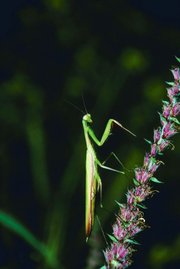Now that summer is in full swing, gardeners have to deal with pests.
While industrial agriculture uses chemicals to control insects, it's a scorch-the-earth policy that kills both good and bad bugs indiscriminately.
In organic growing, we strive to live in harmony with the plant and animal nations. As such, we want to grow plants that repel unwanted insects and invite beneficial insects to take care of those that might want to feast on our plants.
Several plants can be useful in controlling unwanted pests, such as alyssum, buckwheat, coriander, dill, fennel, Queen Anne's Lace, sunflowers and common yarrow. Not only do these plants look great, they attract the kinds of insects that will help protect your garden. Some, like sunflowers, act as a "trap crop," luring pests to them and away from the rest of your garden. Others, like dill, fennel and coriander, are herbs that you can use in your food. Buckwheat is incredibly appealing to pollinators such as honeybees and butterflies.
American Indian tribes have traditionally considered yarrow to have mystical and magical properties—from love charms to warding off negativity. The Latin name for the plant (also known as millfoil) is Achillae, named for the Greek warrior Achilles. Legend has it that Achilles gave the plant to his troops to stop bleeding. The Chinese have used dried yarrow stems for I Ching divination for centuries. And gardeners who use the principles of biodynamic farming use yarrow as a basic ingredient to invite spirit elementals to the garden.
Placing beneficial plants in your garden isn't difficult and you don't have to follow a specific plan; plant them here and there, wherever the mood strikes you, in and around the garden or along a ditch. They should all grow quickly.
To provide a little help for the humans in your garden, plant something that will help naturally ward off mosquitoes. Mother Earth News tested a number of plants and these were the top natural repellents: lantana, rose-scented monarda, lime basil, catnip, sacred basil and thyme (see tinyurl.com/74gwysm). Again, these plants have other uses as well—including happy cats! Planting them in pots or other containers allows you to place them on your porch or patio, as well.
Find heirloom or organic seeds for all of these plants at your local garden store—or, at this time of year, look for full-grown plants on sale at a discount.
In addition to attracting beneficial insects with plants, you can simply purchase them. Those little red beetles with black dots, affectionately called ladybugs, are popular. Ladybugs are capable of consuming up to 50 or 60 aphids per day, and one ladybug can consume many as 5,000 aphids in its lifetime, according to Peaceful Valley Farm and Garden Supply (groworganic.com), which sells the little critters online. Ladybugs also eat a variety of other harmful insects and larvae including scales, mealy bugs, leafhoppers, mites and various types of soft-bodied insects.
Next year, you might consider the praying mantid (or mantis). These big green bugs eat aphids, beetles, flies, mosquitoes, moths, caterpillars, wasps—generally, any insect it can catch. A praying mantid's egg sac can contain up to 40,000 eggs, which usually hatch in spring. Find them for sale online and from stores such as Costco.
Finally, if you are finding strange plant symptoms or pest invaders, check out this handy online resource for finding safe, non-toxic pesticide solutions that are Organic Materials Review Institute, or OMRI, approved: The Ecological Pest Management Database (bit.ly/g6Eqgu). It covers solutions for everything from diseases to weeds to mollusks. The database is maintained by the Butte, Mont.-based National Sustainable Agriculture Information Service. Call them at 1-800-346-9140.



Comments
Use the comment form below to begin a discussion about this content.